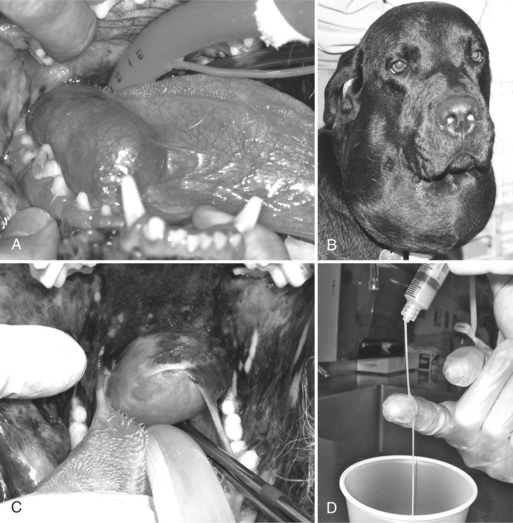S
Salivary Gland Disorders
BASIC INFORMATION 
DEFINITION
CLINICAL PRESENTATION
HISTORY, CHIEF COMPLAINT
 SALIVARY GLAND DISORDERS Sialoceles in dogs: A, Sublingual (right-sided). B, Cervical (originating from the right side). C, Pharyngeal (left-sided). D, Nontransparent, stringy, brownish fluid aspirated from a sialocele.
SALIVARY GLAND DISORDERS Sialoceles in dogs: A, Sublingual (right-sided). B, Cervical (originating from the right side). C, Pharyngeal (left-sided). D, Nontransparent, stringy, brownish fluid aspirated from a sialocele.(Copyright 2010 Alexander M. Reiter.)
PHYSICAL EXAM FINDINGS: All: see also History/Chief Complaint, above.
ETIOLOGY AND PATHOPHYSIOLOGY
DIAGNOSIS 
INITIAL DATABASE
TREATMENT 
ACUTE GENERAL TREATMENT
CHRONIC TREATMENT
POSSIBLE COMPLICATIONS
PROGNOSIS AND OUTCOME 
PEARLS & CONSIDERATIONS 
COMMENTS
Boydell P, et al. Sialadenosis in dogs. J Am Vet Med Assoc. 2000;216:872.
Hammer A, et al. Salivary gland neoplasia in the dog and cat: survival times and prognostic factors. J Am Anim Hosp Assoc. 2001;37:478.
Schroeder H, Berry WL. Salivary gland necrosis in dogs: a retrospective study of 19 cases. J Small Anim Pract. 1998;39:121.
Smith MM. Oral and salivary gland disorders. In: Ettinger SJ, Feldman EC, editors. Textbook of veterinary internal medicine. ed 6. Philadelphia: WB Saunders; 2005:1290-1297.
Spangler WL, Culbertson MR. Salivary gland disease in dogs and cats: 245 cases (1985-1988). J Am Vet Med Assoc. 1991;198:465.
Salmon Poisoning
BASIC INFORMATION 
EPIDEMIOLOGY
SPECIES, AGE, SEX: Dogs: any age, both sexes affected
RISK FACTORS: Exposure to a fresh brackish stream or beach is commonly elicited in the history.
GEOGRAPHY AND SEASONALITY: Infections are limited to the habitat range of the intermediate snail host (Oxytrema silicula) in western British Columbia, Washington, Oregon, northern California, and more sporadically in areas where fish carrying the causative organism, N. helminthoeca, migrate or are transported. Dogs have the greatest access to dead fish during spawning seasons (late summer to early winter).



